httpd.2.4 配置文件相关指令详解
1、Listen指令 及 PidFile 指令
Listen指令是为了设置监听套接字 。PidFile指令是为了指定httpd的PidFile文件。
语法:Listen [IP-address:]portnumber [protocol]
语法2:PidFile filename
Listen 80 # 设置侦听端口 Listen 127.0.0.1:80 # 设置侦听ip 及 端口 Listen 192.168.4.150:8000 Listen 192.168.4.150:8443 https # 侦听 ip 192.168.4.150 8443端口 https 协议 <IfModule !mpm_netware_module> PidFile "/var/run/httpd/httpd.pid" # 指定PidFile文件为 /var/run/httpd/httpd.pid </IfModule>
2、ServerRoot指令
该指令设置httpd的安装位置,编译安装时可通过"--prefix"选项指定,如--prefix=/usr/local/apache ;
不建议安装完成后,变更不同的路径 :因为在配置文件中,部分指令路径是依赖该httpd的根路径的相对路径。
语法:ServerRoot directory-path
ServerRoot "/usr/local/apache" # httpd 安装目录
3、DocumentRoot 指令及根目录页面访问属性
指定server站点的根目录。使用rpm包安装的httpd的DocumentRoot默认值为"/var/www/html";编译安装的httpd时,其DocumentRoot默认为"$ServerRoot/htdocs"
语法:DocumentRoot directory-path
-
Options指令选项:
Indexes:缺少指定的页面时,允许将目录中的所有文件列举出来;除非是提供文件下载,否则出于安全考虑,这个选项是强烈建议关闭的
FollowSymLinks :允许跟随符号链接所指向的原始文件;出于安全考虑,这个选项建议关闭
ExecCGI:允许使用mod_cgi 模块执行CGI脚本
Includes:允许使用mod_include模块实现服务器端包含(SGI)
MultiViews:允许使用mod_negotiation实现内容协商
SymLinksIfOwnerMatch:在链接文件属主属组域原始文件属主属组相同时,允许跟随符号链接所指向的原始文件
-
AllowOverride 指令选项:用于控制是否读取".htaccess"配置文件。
all:启用AllowOverride特性
none:禁用AllowOverride特性。
AuthConfig:基于用户认证时设置该值,此时将可以使用AuthGroupFile, AuthName, AuthType, AuthUserFile,Require等认证相关指令。
FileInfo: 控制文档类型时使用该值,此时将可以使用ErrorDocument, SetHandler,以及一些URL重写的指令。
Indexes:控制目录索引时使用该值,此时可以使用AddIcon, DirectoryIndex。
Limit:是否允许使用order、allow、deny指令,这三个指令已经废弃,目前还存在是为了兼容老版本。
-
Require指令选项:实现对用户访问限制
Require all granted :所有用户允许访问
Require all dined :所有用户禁止访问
Require Valid-user :仅允许有效用户进行访问
Require user userid [userid] ... 仅允许userid用户进行访问
Require group Group-name [group-name] ... 仅允许Group-name组内用户进行访问
-
Order 指令: 实现对用户的访问限制
Order Allow,Deny # 定义权限,先允许 ,后拒绝 ;在规则中,若二者都匹配或二者都不匹配,则以Order 命令中的第二项为准;否则,则匹配到相关项为准
Allow From IP | network # 允许的ip 或 network
Deny From IP | network # 拒绝的ip 或 network
-
实现用户访问限制方法:以下两个选项二选一 ,不建议同时使用
1、Require all [ granted | dined ] 允许 或 拒绝 所有用户访问
2、通过Order 与 Allow 或Deny 的指令组合来实现。
DocumentRoot "/usr/local/apache/htdocs" #指定server 站点的根目录 ,可改变该路径地址,实现把其他目录作为server根目录 <Directory "/usr/local/apache/htdocs"> # 定义目录属性 Options Indexes FollowSymLinks # 配置目录中可用的功能,包括Indexes ,FollowSymLinks ,None ,All ,ExecCGI等 AllowOverride None # 不允许存在于.htaccess文件中的指令类型 Require all granted | denied # 允许或拒绝 所有用户访问 Order allow,deny # 先允许,在禁止 顺序匹配 ,定义限制用户 Allow from IP | network Deny from IP | network </Directory>
4、DirectoryIndex指令
httpd服务器端将DorectoryIndex指令所指定的文件响应给客户端。如访问 http://www.itwish.cn/ ,将自动把$Document下的index.html 文件内容返回给客户端 。
语法:DirectoryIndex disabled | local-url [local-url]
<IfModule dir_module> DirectoryIndex index.html index.php /cgi-bin/index.pl #从左至右依次查找 ,先查找index.html 文件 ,若没有就查找index.php 文件 ,再没有就查找/cgi-bin/index.pl 文件 </IfModule>
5、Keepalive指令
KeepAlive指令用于开启和关闭持久连接功能。在没有开启持久连接时,客户端每请求一个资源都需重新建立一次TCP连接,而使用了持久连接后,客户端只需在最初请求一次TCP连接,之后就可以使用同一个TCP连接发送其他的http请求;但长连接自身的缺陷是会一直占用着连接不释放,所以必须得给出一个长连接的超时时间,这个超时时间由KeepAliveTimeout指令控制;还可以通过指令MaxKeepAliveRequests控制每个长连接下的TCP连接的能接受的最大请求数。无疑,这个值应该设置的大一些,设置为0表示无限制。
语法1:KeepAlive On|Off
语法2:KeepAliveTimeout num[ms]
语法3:MaxKeepAliveRequests number
[root@VM httpd]# vi /etc/httpd/httpd.conf # Various default settings Include /etc/httpd/extra/httpd-default.conf # 启用扩展配置文件httpd-default.conf [root@VM extra]# vi httpd-default.conf KeepAlive On # 启用HTTP持久连接功能 KeepAliveTimeout 5 # 关闭连接之前等待后续请求的秒数 ,通过添加ms的后缀,表示可设置为毫秒 MaxKeepAliveRequests 50 # 限制打开时每个连接允许的请求数,若为0 ,则不限制
6、DSO 动态共享库加载指令
Apache HTTP Server是一个模块化程序,管理员可以通过加载不同的模块组来选择要包含在服务器中的功能。在编译安装时,通过选项--enable-so 来加载DSO(动态共享对象)功能。通过LoadModule命令来实现关闭或开启功能模块 。
语法:LoadModule status_module "modules/mod_status.so"
[root@vm ~]# vi /etc/httpd/httpd.conf #LoadModule mpm_event_module modules/mod_mpm_event.so LoadModule mpm_prefork_module modules/mod_mpm_prefork.so #LoadModule mpm_worker_module modules/mod_mpm_worker.so LoadModule authn_file_module modules/mod_authn_file.so #LoadModule authn_dbm_module modules/mod_authn_dbm.so #LoadModule authn_anon_module modules/mod_authn_anon.so #LoadModule authn_dbd_module modules/mod_authn_dbd.so #LoadModule authn_socache_module modules/mod_authn_socache.so LoadModule authn_core_module modules/mod_authn_core.so LoadModule authz_host_module modules/mod_authz_host.so LoadModule authz_groupfile_module modules/mod_authz_groupfile.so LoadModule authz_user_module modules/mod_authz_user.so
7、MPM多道处理模块配置指令 及 Include 指令
Apache HTTP 服务器 2.0 扩展此模块化设计到最基本的 web 服务器功能,它提供了可以选择的多处理模块(MPM),可在编译时使用--with-mpm选项来决定apache的工作模式。MPM 很像其它 Apache httpd 模块,主要是区别是任何时间内必须有一个且只能有一个 MPM 模块需加载到服务器中,可用的MPM模块包括prefork ,event ,worker等。可以通过httpd -M命令列出apache的所有模块,查看相应其工作方式。
Include 指令是用于在httpd启动时,使用include指令来包含其他配置文件,在解析配置文件时会把主配置文件httpd.conf 与include 包含的文件进行配置合并 ,实现整体对 httpd 的配置调节。
语法:Include file-path|directory-path|wildcard
[root@vm ~]# vi /etc/httpd/httpd.conf LoadModule mpm_event_module modules/mod_mpm_event.so # 手动加载的mod_mpm模块 #LoadModule mpm_prefork_module modules/mod_mpm_prefork.so # 若更改mpm_prefork或mpm_worker模块,其余两种模块行注释 #LoadModule mpm_worker_module modules/mod_mpm_worker.so # Server-pool management (MPM specific) Include /etc/httpd/extra/httpd-mpm.conf # 启动httpd-mpm.conf 扩展配置文件 [root@vm ~]# vi /etc/httpd/extra/httpd-mpm.conf <IfModule mpm_prefork_module> StartServers 5 # 开机启动的工作进程数 MinSpareServers 5 # 保留备用的最小工作进程数 MaxSpareServers 10 # 保留备用的最大工作进程数 MaxRequestWorkers 250 # httpd启动时开启的最大工作进程数 MaxConnectionsPerChild 0 # 服务器进程所服务的最大连接数,0代表不限制 </IfModule> <IfModule mpm_worker_module> StartServers 3 # 启动的子进程的个数 MinSpareThreads 75 # 保留备用的最小工作线程数 MaxSpareThreads 250 # 保留备用的最大工作线程数 ThreadsPerChild 25 # 服务器进程的工作线程数 MaxRequestWorkers 400 # 服务器最大工作线程数 MaxConnectionsPerChild 0 # 服务器的最大进程连接数 ,0代表不做限制 </IfModule> <IfModule mpm_event_module> StartServers 3 # 启动的子进程的个数 MinSpareThreads 75 # 保留备用的最小工作线程数 MaxSpareThreads 250 # 保留备用的最大工作线程数 ThreadsPerChild 25 # 服务器进程的工作线程数 MaxRequestWorkers 400 # 服务器最大工作线程数 MaxConnectionsPerChild 0 # 服务器的最大进程连接数 ,0代表不做限制 </IfModule> </IfModule>
8、ServerName,ServerAdmin及ServerAlias
ServerName用于唯一标识提供web服务的主机名,只有在基于名称的虚拟主机中该指令才是必须的 。ServerAlias用于定义ServerName的别名。 ServerAdmin 是用于定义管理邮箱地址。
语法1:ServerName [scheme://]domain-name|ip-address[:port]
语法2:ServerAdmin email-address|URL
语法3:ServerAlias hostname [hostname]
[root@VM httpd]# vi httpd.conf # ServerAdmin: Your address, where problems with the server should be # e-mailed. This address appears on some server-generated pages, such # as error documents. e.g. admin@your-domain.com # ServerAdmin web@itwish.cn # 定义Server管理员邮箱地址 # # ServerName gives the name and port that the server uses to identify itself. # This can often be determined automatically, but we recommend you specify # it explicitly to prevent problems during startup. # # If your host doesn't have a registered DNS name, enter its IP address here. # ServerName www.itwish.cn:80 # 定义主机名称 [root@VM httpd]# vi extra/httpd-vhosts.conf <VirtualHost *:80> ServerAdmin webmaster@itwish.cn # 定义Server管理员邮箱地址 ServerName www.itwish.cn # 定义主机名称 ServerAlias www # 定义主机别名 </VirtualHost>
9、Userdir指令,配置用户目录
允许每个用户使用该UserDir指令在其主目录中拥有一个网站。可通过http://example.com/~username/ 进行访问 ,注:务必要为用户的家目录赋予运行httpd进程的用户daemon拥有执行权限
语法:UserDir directory-filename [directory-filename] ...
[root@VM httpd]# vi /etc/httpd/httpd.conf LoadModule authz_host_module modules/mod_authz_host.so # 加载userdir 依赖的动态DSO文件 ,取消注释“#” 即可实现加载。 LoadModule authz_core_module modules/mod_authz_core.so LoadModule userdir_module modules/mod_userdir.so # User home directories Include /etc/httpd/extra/httpd-userdir.conf # 包含扩展文件 httpd-userdir.conf [root@VM httpd]# vi extra/httpd-userdir.conf # Required module: mod_authz_core, mod_authz_host, mod_userdir # 该功能依赖DSO 动态模块 mod_authz_core,mod_authz_host, mod_userdir UserDir public_html # 定义用户访问目录名称 # public_html是用户家目录下的目录名称,所有位于此目录中的文件均可通过url http://example.com/~username进行访问 <Directory "/home/*/public_html"> # 定义目录页面属性 AllowOverride FileInfo AuthConfig Limit Indexes # 配置AllowOverride 指令 Options Indexes FollowSymlinks # 配置Options 指令 Require all granted # 配置Require 指令 </Directory> [root@VM httpd]# useradd itwish # 添加用户及配置密码 [root@VM httpd]# passwd itwish [root@VM itwish]# mkdir /home/itwish/public_html # 在用户家目录下创建Userdir 定义的目录文件 [root@VM itwishl]# touch /home/itwish/public_html/{a,b,c} [root@VM itwish]# setfacl -m u:daemon:x /home/itwish/ # 注:务必要为用户家目录配置httpd启动用户daemon的执行权限
测试itwish用户的个人网站:
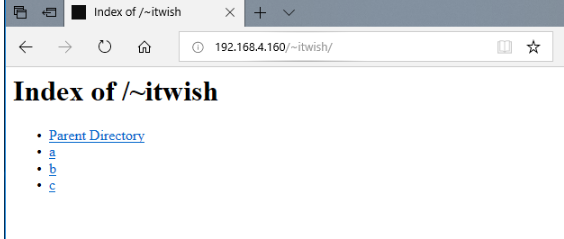
10、ScriptAlias 指令,配置脚本执行目录
将URL映射到文件系统位置,并将目标指定为CGI脚本。例:Script Alias "cgi-bin" "/usr/local/apache/cgi-bin/" 表示访问 http://www.itwish.cn/cgi-bin/test 时,目录映射地址为 /usr/local/apache/cgi-bin/test
语法1:ScriptAlias [URL-path] file-path|directory-path
# 定义/cgi-bin/ 目录映射到 /web/cgi-bin/ 目录 ,1)功能等同于2) ,注意结尾的"/" 1) ScriptAlias "/cgi-bin/" "/web/cgi-bin/" 2) Alias "/cgi-bin/" "/web/cgi-bin/" <Location "/cgi-bin"> SetHandler cgi-script Options +ExecCGI </Location>
[root@VM httpd]# vi extra/httpd-vhosts.conf # 调整配置文件 <IfModule alias_module> # ScriptAlias /cgi-bin/ "/usr/local/apache/cgi-bin/" # 定义目录/cgi-bin/ 目录映射到 /usr/local/apache/cgi-bin/ 目录 </IfModule> <Directory "/usr/local/apache/cgi-bin"> # 定义目录属性 AllowOverride none Options none Require all granted </Directory> [root@VM cgi-bin]# vi test1 # 在cgi-bin目录中创建test1 bash 脚本 #!/bin/bash cat << EOF Content-Type: text/html # 注意改行为空行 <pre> <h1>The hostname is `hostname`. </h1> # 显示主机名 ,使用bash命令 hostname 实现 The time is `date`. # 显示当前访问日期 ,使用bash命令 date 实现 </pre> # 改行为空行 EOF [root@VM cgi-bin]# vi test2 # 在cgi-bin目录中创建test2 perl 脚本 #!/usr/bin/perl print "content-type: text/html","\n\n"; print "<HTML>","\n"; print "<HEAD>","\n"; print "<TITLE>Perl</TITLE>","\n"; print "</HEAD>","\n"; print "<BODY>","\n"; print "<H1>Hello World</H1>","\n"; print "</BODY>","\n"; print "</HTML>","\n"; [root@VM ]# chmod o+x /usr/local/apache/cgi-bin/{test1,test2} # 注意 ,一定要给与脚本执行权限 [root@VM cgi-bin]# curl http://192.168.4.160/cgi-bin/test1 # 测试 test1 脚本执行状况 <pre> <h1>The hostname is VM. </h1> The time is Wed Aug 15 19:26:56 CST 2018. </pre> [root@VM cgi-bin]# curl http://192.168.4.160/cgi-bin/test2 # 测试test2 perl脚本执行状况 <HTML> <HEAD> <TITLE>Perl</TITLE> </HEAD> <BODY> <H1>Hello World</H1> </BODY> </HTML>
windows测试:
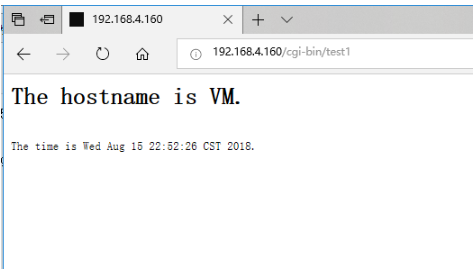
11、VirtualHost指令 ,虚拟主机配置
<VirtualHost>及</VirtualHost>用于包含一组仅适用于特定虚拟主机的指令。当服务器在特定虚拟主机上收到对文档的请求时,它将使用该<VirtualHost> 部分中包含的配置指令。
语法:<VirtualHost addr[:port] [addr[:port]] ...> ... </VirtualHost>
-
addr可以是以下任何一个,可选地后跟冒号和端口号(或*):
虚拟主机的IP地址 ;
虚拟主机IP地址的完全限定域名(不推荐);
字符 * ,充当通配符并匹配任何IP地址;
字符串"_default_",是"*"的别名
[root@VM httpd]# vi /etc/httpd/httpd.conf # 调整httpd.conf 主配置文件 #DocumentRoot "/usr/local/apache/htdocs" # 注释掉web站点的根目录 ,行首加 “#”。 Include /etc/httpd/extra/httpd-vhosts.conf # 取消行首的注释“#” ,使能httpd-vhosts.conf 文件 [root@VM httpd]# vi extra/httpd-vhosts.conf <VirtualHost 192.168.4.160:80> # 定义虚拟主机的访问ip为 192.168.4.160:80 ,访问主机名 www.itwish.cn ServerAdmin webmaster@itwish.cn # 定义主机管理邮箱地址 DocumentRoot "/usr/local/apache/htdocs/itwish.cn" # 定义该虚拟主机的根目录 ServerName www.itwish.cn # 定义虚拟主机名称 ServerAlias www.itwish.cn # 定义Servername 的别名 ErrorLog "logs/itwish.cn-error_log" # 定义错误日志路径 CustomLog "logs/itwish.cn-access_log" common # 定义访问日志目录 <Directory "/usr/local/apache/docs/itwish.cn"> # 对根目录设置页面访问属性 ,定义Directory 指令开始范围 Options Indexes FollowSymlinks AllowOverride None Require all granted </Directory> # 定义Directory 指令结束范围 </VirtualHost> # 定义VirtualHost 指令的结束范围 <VirtualHost 192.168.4.170:80> # 定义虚拟主机的访问ip为 192.168.4.160:80 ,访问主机名 www.itwish.cn ServerAdmin webmaster@itwish.org DocumentRoot "/usr/local/apache/htdocs/itwish.org" ServerName www.itwish.org ServerAlias www.itwish.org ErrorLog "logs/itwish.org-error_log" CustomLog "logs/itwish.org-access_log" common <Directory "/usr/local/apache/docs/itwish.org"> Options Indexes FollowSymlinks AllowOverride None Require all granted </Directory> </VirtualHost> [root@VM httpd]# mkdir /usr/local/apache/htdocs/{itwish.cn,itwish.org} # 创建虚拟主机的根目录 [root@VM httpd]# cd /usr/local/apache/htdocs/ [root@VM htdocs]# ls index.html itwish.cn itwish.org [root@VM htdocs]# vi itwish.cn/index.html # 编辑虚拟主机 www.itwish.cn 访问主页 <html><body><h1>www.itwish.cn works!</h1></body></html> [root@VM htdocs]# vi itwish.org/index.html # 编辑虚拟主机 www.itwish.org 访问主页 <html><body><h1>itwish.org works!</h1></body></html> [root@VM httpd]# vi /etc/hosts # 添加以下虚拟主机域名解析 地址 192.168.4.160 vm.itwish.cn vm www.itwish.cn 192.168.4.170 www.itwish.org [root@VM htdocs]# curl http://www.itwish.cn # 测试 ,主页面显示正常 <html><body><h1>www.itwish.cn works!</h1></body></html> [root@VM htdocs]# curl http://www.itwish.org # 测试 ,主页面显示正常 <html><body><h1>itwish.org works!</h1></body></html>
windows 主机测试,简要实现 ,未配置域名解析 ,直接通过ip进行访问:
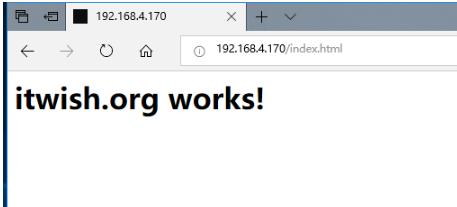
12、ErrorLog 与 LogFormat 指令,定义web访问 Log日志
定义web访问日志路径及日志格式
语法1:ErrorLog file-path|syslog[:[facility][:tag]]
语法2:LogFormat format|nickname [nickname]
语法3:CustomLog file|pipe format|nickname [env=[!]environment-variable| expr=expression]
-
定义日志格式各项参数涵义,请参考官网文档:https://httpd.apache.org/docs/2.4/mod/mod_log_config.html#formats
%h:客户端地址
%l:远程的登录名,通常为-
%u:认证时的远程用户名,通常为-
%t:接收到的请求时的时间,为标准英文格式时间+时区
\" :斜杠时为后面内容做转义
%r:请求报文的起始行
%>s:响应状态码,
%b:以字节响应报文的长度,不包含http报文
%{Header_Name}i:记录指定请求报文首部的内容(value)
%u:请求的URL
-
常用日志格式:
通用日志格式(CLF): "%h %l %u %t \"%r\" %>s %b"
虚拟主机的通用日志格式:"%v %h %l %u %t \"%r\" %>s %b"
NCSA扩展/组合日志格式 :"%h %l %u %t \"%r\" %>s %b \"%{Referer}i\" \"%{User-agent}i\""
引用日志格式 :"%{Referer}i -> %U"
代理(浏览器)日志格式: "%{User-agent}i"
[root@VM httpd]# vi /etc/httpd/httpd.conf # 调整httpd.conf 主配置文件 ErrorLog "logs/error_log" # 错误日志路径 LogLevel warn # 日志等级warn <IfModule log_config_module> # LogFormat "%h %l %u %t \"%r\" %>s %b \"%{Referer}i\" \"%{User-Agent}i\"" combined # 定义日志格式,格式名称定义为变量 combined LogFormat "%h %l %u %t \"%r\" %>s %b" common # 定义日志格式,格式名称定义为变量 common <IfModule logio_module> # You need to enable mod_logio.c to use %I and %O LogFormat "%h %l %u %t \"%r\" %>s %b \"%{Referer}i\" \"%{User-Agent}i\" %I %O" combinedio </IfModule> CustomLog "logs/access_log" common # 该CustomLog指令用于将请求记录到服务器。指定了日志路径,并且选择使用环境变量common作为日志的显示格式。 </IfModule> [root@VM httpd]# vi extra/httpd-vhosts.conf <VirtualHost 192.168.4.160:80> ErrorLog "logs/itwish.cn-error_log" CustomLog "logs/itwish.cn-access_log" combined # 把日志格式变量从common 改为 combined 或者 CustomLog "logs/itwish.cn-access_log" "%v %h %l %u %t \"%r\" %>s %b" </VirtualHost> [root@VM httpd]# vi /usr/local/apache/logs/itwish.cn-access_log # 查看访问日志 ,通过日志显示内容对比 common变量格式 与 combined 变量格式的不同 192.168.4.160 - - [15/Aug/2018:15:56:40 +0800] "HEAD / HTTP/1.1" 200 - 192.168.4.160 - - [15/Aug/2018:15:56:52 +0800] "GET / HTTP/1.1" 200 105 192.168.4.201 - - [15/Aug/2018:16:00:13 +0800] "GET /favicon.ico HTTP/1.1" 404 209 192.168.4.201 - - [15/Aug/2018:16:00:17 +0800] "GET /favicon.ico HTTP/1.1" 404 209 192.168.4.201 - - [15/Aug/2018:17:20:01 +0800] "GET / HTTP/1.1" 304 - "-" "Mozilla/5.0 (Windows NT 10.0; Win64; x64) AppleWebKit/537.36 (KHTML, like Gecko) Chrome/67.0.3 396.99 Safari/537.36" 192.168.4.201 - - [15/Aug/2018:17:20:06 +0800] "GET / HTTP/1.1" 200 57 "-" "Mozilla/5.0 (Windows NT 10.0; Win64; x64) AppleWebKit/537.36 (KHTML, like Gecko) Chrome/64.0. 3282.140 Safari/537.36 Edge/17.17134"
13、httpd网页认证
httpd对web身份认证的支持很丰富,提供的控制也非常细致。见http://httpd.apache.org/docs/2.4/mod/
-
认证方式
httpd服务器支持使用摘要认证(Digest)和基本认证(Basic)两种方式
Digest:使用摘要认证需要在编译httpd之前添加"--enable-auth-digest"选项,但并不是所有的浏览器都支持摘要认证,不推荐使用;
Basic:基本认证是htpd服务的基本功能,不需要预先配置特别的选项(安全性没有摘要认证高,但支持所有的浏览器)
-
通过用户名和密码形式限制访问方式:
AllowOverride Authconfig # 启用用户认证
AuthName "Auth Direcrory" # 指定认证名称,登录的时候会通过登录窗口显示
AuthType Basic | Digest # 指定认证方式 Basic 或 Digest
AuthUserFile /usr/local/apache/.htpasspwd # 指定授权用户数据文件,由htpasswd命令生成。
AuthGroupFile file-path # 指定组认证文件,文件中分组格式为"mygroup: Jon Bob "。如果文件路径为相对路径,则相对于ServerRoot
Require valid-user # 授权给合法用户,合法用户在.htpasspwd文件中
[root@VM httpd]# vi /etc/httpd/httpd.conf # 调整httpd.conf 主配置文件 #DocumentRoot "/usr/local/apache/htdocs" # 注释掉web站点的根目录 ,行首加 “#”。 Include /etc/httpd/extra/httpd-vhosts.conf # 取消行首的注释“#” ,使能httpd-vhosts.conf 文件 [root@VM httpd]# vi extra/httpd-vhosts.conf <VirtualHost 192.168.4.170:80> # 定义虚拟主机的访问ip为 192.168.4.160:80 ,访问主机名 www.itwish.cn ServerAdmin webmaster@itwish.org DocumentRoot "/usr/local/apache/htdocs/itwish.org" # 定义该虚拟主机的根目录 ServerName www.itwish.org ServerAlias www.itwish.org ErrorLog "logs/itwish.org-error_log" # 定义错误日志路径 CustomLog "logs/itwish.org-access_log" common # 定义web访问日志目录及日志格式 <Directory "/usr/local/apache/htdocs/itwish.org"> # 对根目录设置页面访问属性 ,定义Directory 指令开始范围 Options Indexes FollowSymlinks AllowOverride Authconfig # 定义用户访问认证 AuthType Basic AuthName "Input Your name and password" AuthUserFile "/usr/local/apache/.htpasspwd" # 用户认证文件 AuthGroupFile "/usr/local/apache/.group" # 组认证文件 Require Valid-user # 或者直接使用 Require user itwish,tom Require group Auth # 允许 </Directory> # 定义Directory 指令结束范围 </VirtualHost> # 定义VirtualHost 指令的结束范围 [root@VM httpd]# htpasswd -cb /usr/local/apache/.htpasspwd itwish itwish # 添加认证用户并指定认证文件 Adding password for user itwish [root@VM httpd]# htpasswd -b /usr/local/apache/.htpasspwd tom tom # 添加认证用户 Adding password for user tom [root@VM httpd]# echo "Auth:tom" >> /usr/local/apache/.groupname # 添加用户到认证组Auth [root@VM httpd]# vi /usr/local/apache/.groupname Auth:tom
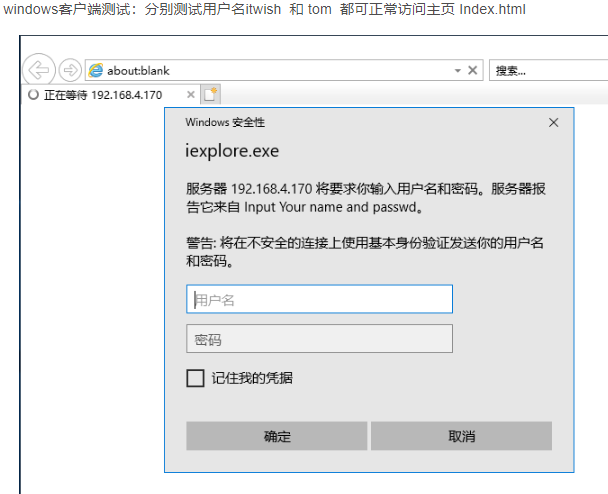
14、<Location> 指令 ,SetHandler 指令 ,配置主页stauts 页面
该<Location>指令通过URL限制所附指令的范围。它与<Directory> 指令类似 ,并启动一个以</Location>指令终止的子节 .
[root@VM httpd]# vi httpd.conf # 配置httpd.conf主文件,并加载以下DSO模块 LoadModule authz_host_module modules/mod_authz_host.so LoadModule authz_core_module modules/mod_authz_core.so LoadModule status_module modules/mod_status.so LoadModule info_module modules/mod_info.so # Real-time info on requests and configuration Include /etc/httpd/extra/httpd-info.conf # 启用扩展文件 [root@VM extra]# vi httpd-info.conf # 配置httpd-info.conf文件,建议指定用户访问。 # # Get information about the requests being processed by the server # and the configuration of the server. # # Required modules: mod_authz_core, mod_authz_host, # 依赖指定的模块 # mod_info (for the server-info handler), # mod_status (for the server-status handler <Location /server-status> SetHandler server-status AllowOverride Authconfig # 配置用户认证 Authtype Basic AuthName "Input The message" AuthUserFile "/usr/local/apache/.htpasspwd" Require Valid-user </Location>
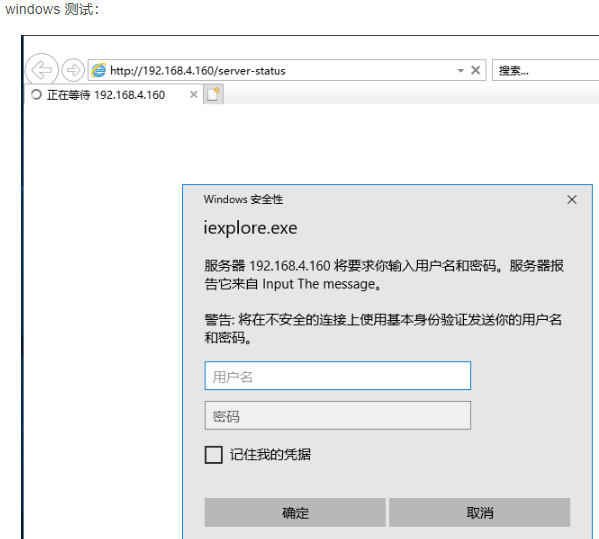
摘: https://blog.csdn.net/sinat_32596537/article/details/91528913


